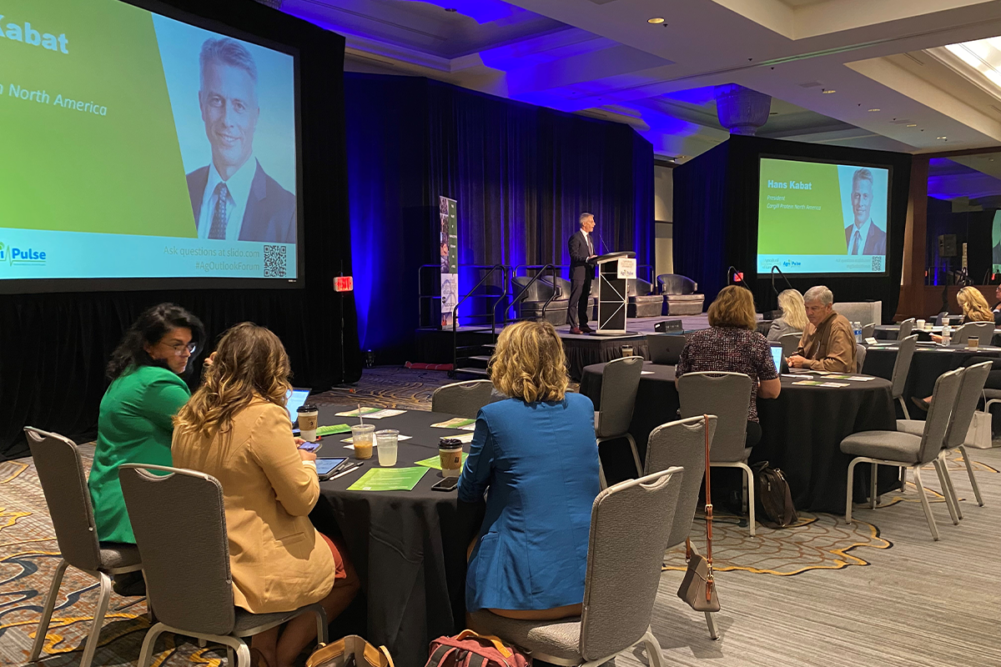KANSAS CITY, MO. — The question on everyone’s mind at this year’s ninth annual Ag Outlook Forum, organized by Agri-Pulse and the Agricultural Business Council of Kansas City, was, “How do we feed a growing population of 8 billion people?” Speakers from a vast array of agricultural backgrounds offered solutions and insights into this worldwide problem as well as a rundown on the state of the agriculture sector at large.
One of the opening speakers at the 2023 Ag Outlook Forum, which was held at the Kansas City Marriott Downtown on Sept. 25, was Hans Kabat, president of Cargill Protein North America.
Kabat addressed how Cargill is navigating current industry challenges, including climate change, new technologies, rural flight and shifting economics that lend to the difficulty of feeding the world.
“Change is a constant in our industry, and lately change has been happening at a dizzying rate,” he said. “We need to imagine new possibilities for us. From our perspective at Cargill, we think it's possible to reframe these challenges as opportunities. It's led me to believe that all of us — and those of us in the food industry in particular — have a good reason to be optimistic.”
Driving that optimism is innovation and collaboration.
“As a partner to farmers, NGOs, industry groups, governments and manufacturers, we know that all of us need to work together to solve those problems,” Kabat said.
Within the past couple years, Cargill has launched two programs to help facilitate a combined effort across the agricultural community to improve sustainable practices.
The BeefUp Sustainability program, which was organized in partnership with Cargill, Nestlé and the National Fish and Wildlife Foundation, supports regenerative agriculture of 1.7 million acres of the United States’ land over the next five years. Through this initiative, Cargill estimates that 845,000 tonnes of carbon dioxide will be sequestered.
BeefUp provides technical and financial support for ranchers to implement regenerative practices through a $30 million investment into the program.
Future investments are expected to come through 2030, totaling $80 million and impacting 5.2 million acres of land.
In 2021, Cargill launched its RegenConnect program, which compensates farmers for adopting climate-friendly practices. That program expanded to reach farmers in Europe in May this year.
Since its inception, RegenConnect has had around 1,000 farms and 625,000 acres enrolled in the program, and $7 million in cash payments have been given to farmers.
“By providing farmers financial incentive for positive environmental contributions, we can help mitigate climate change, improve soil health and decarbonize the global food supply,” Kabat said.
Farm Bill in the throes
Stakeholders wait anxiously for the finalization of the 2023 Farm Bill to bring additional solutions to the food insecurity crisis and bolster the support for producers working to feed the world.
Joining a panel moderated by Blake Hurst of Hurst Farms, and former president of Missouri Farm Bureau, were Congressman Tracey Mann (R-Kan.) and Congresswoman Sharice Davids (D-Kan.). Mann and Davids offered a look at ongoing discussions within the Agriculture Committee.
With the expiration date for the current Farm Bill coming up on Sept. 30, Davids confirmed that the ag committee is not optimistic about passing the bill before then. Nevertheless, she assured attendees at the Ag Outlook Forum that the Senate and House of Representatives are prioritizing passing the bill.
“There is a sense of urgency for both the folks in the Senate and the House to get this done,” she said.
Mann pointed out that as the end of the crop year rolls around on Dec. 31, crop insurance policies and related regulations will revert back to the original legislation passed in the 1930s without a new amendment or an extension of some kind. Seeing as “no one wants to go back” to outdated policies, Mann said he was confident an extension would be issued if the 2023 Farm Bill is not enacted by that time.
“I think we have got to remember that Farm Bills are five-year policies for a reason,” he said. “Long enough to provide certainty for our producers but short enough so that we are looking at these policies and making sure that we are updating it and it’s changing with the times.”
While the Farm Bill consists of 81% food nutrition policies, both Mann and Davids still placed crop insurance and agriculture research as top priorities for the legislation.
Despite the challenges Congress faces in reaching agreement on the Farm Bill, Hurst noted that the legislation has held strong for almost 90 years and has greatly improved farmers’ average household income.
“It is important to remember that in 1934, when my grandfather signed that first contract, farm households were about 40% of the average household income,” Hurst said. “Today, farm households enjoy an income that’s around 120% of the US average. Gratitude for the hard work that has gone into 90 years of farm bills is in order.”



